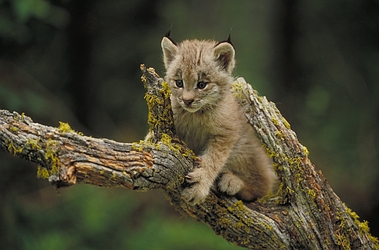The Canada Lynx


- Common Name: Canada Lynx
- Scientific Class: Mammalia
- Scientific Genus: Lynx
- Species: Lynx canadensis
Where It's Found
- Biome: High altitude forests with dense shrubs,reeds,and grass;Taiga
- Countries: Canada, northern United States (major populations in Alaska, western Montana, and nearby parts
- of Idaho and Washington; small population in New England and Utah and possibly in Oregon, Wyoming and Colorado)

Special Adaptations
- Sharp claws for hunting (catching prey), fighting and climbing
- Fur between toes acts like a snowshoe, helps the lynx walk on deep snow
- Fur on paws keeps feet warmer in winter
- Extra thick coat for winter, sheds coat in spring
- Large eyes and ears for excellent sight and hearing
- Migrates if not enough to eat in its territory
Description
- Length: 3 feet
- Height: 2 feet
- Weight: 15-35 lbs.
- Type of Body Covering: Fur
- General Description:
- Summer coat is normally reddish-brown and much shorter than winter coat
- Winter coat is longer, light gray,spotted, with silver tips
- Ears tipped with tufts of long black hair
- Tail is black-tipped all the way around
- Name of Young: kitten
- Name of a group of this animal:pack
- Related to:Snow tiger,bobcat
- Type of eater:Carnivore;ex snow hare
Food Chain
green arrow =energy
blue arrow= What eats what

Symbiotic Relationship
It has a commensalism symbiotic relationship with the snowshoe hare. When there are fewer hares to eat, the lynx population goes down.
Forms of Communication
- Good eyesight and excellent hearing help with hunting.
- There's tactile communication (touching) between mates and between mothers and kittens.
- Vocalization also occur.
Interesting and Unusual Behaviors
- It will travel up to 19 km. in one day to hunt.
- It makes its den under a bush or fallen tree, or in a hollow log.
- It hides its leftover meat.
Endangered Species
It is endangered by humans hunting it.
Sources
http://en.wikipedia.org/wiki/Lynx
http://animaldiversity.ummz.umich.edu/site/accounts/information/Lynx_canadensis.html
http://www.saskschools.ca/-gregory/animals/lynx.html
Encyclopedia of Animals,Amber books,2006
Comments (3)
wikiuser0055 said
at 12:37 pm on Dec 2, 2008
Very nicely done! So easy to read! Great work,
Mrs. G
wikiuser0046 said
at 10:02 am on Dec 4, 2008
HEY WHO'S IS THIS????
wikiuser0046 said
at 10:02 am on Dec 4, 2008
HEY WHO'S IS THIS????
You don't have permission to comment on this page.